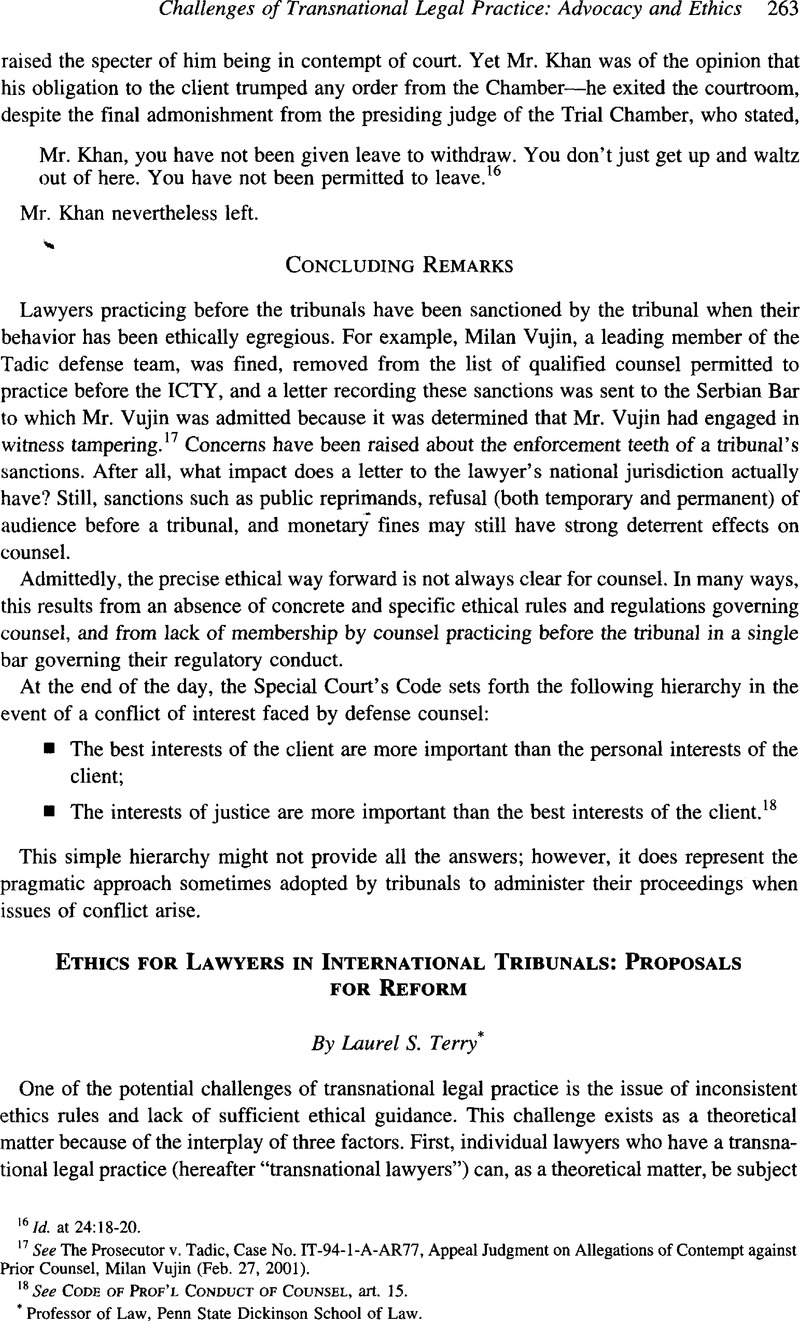No CrossRef data available.
Published online by Cambridge University Press: 28 February 2017

1 See Model Rule of Prof’l Conduct R. 8.5(a) (2009), available at <http://www.abanet.org/cpr/mrpc/mrpc_toc.html>.
2 See, e.g., Council Directive 77/249, Facilitate the Effective Exercise by Lawyers of Freedom to Provide Services, 1977 O.J. (L 78) 17 (EC) art. 4(2); Council Directive 98/5, Facilitate Practice of the Profession of Lawyer on a Permanent Basis in a Member State Other Than that in Which the Qualification was Obtained, 1998 O.J. (L 77) 36 (EC) art. 6(1).
3 See, e.g., Spronken, Tara & Fermon, Jan, Protection of Attorney-Client Privilege in Europe, 27 Penn St. Int’l L. Rev. 439 (2008)Google Scholar; Bannier, Floris, Conflicts of Interest: The Dutch Position, 27 Penn St. Int’l L. Rev. 315 (2008)Google Scholar; Eversheds, Attorney-Client Privilege in Europe: Understanding How the Relationship Works (2008), available at <https://www.eversheds.com/documents/AttorneyClientPrivilege.pdf>.
4 See supra notes 1 and 2. See also Hellwig, Hans-Jürgen, At the Intersection of Legal Ethics and Globalization: International Conflicts of Law in Lawyer Regulation, 27 Penn St. Int’l L. Rev. 395 (May 2008)Google Scholar. I have been advised by a number of lawyers that their jurisdiction lacks a choice of law provision for ethics rule conflicts.
5 Model Rule of Prof’l Conduct R. 8.5(bl)(l), supra note 1, states in pertinent part: “In any exercise of the disciplinary authority of this jurisdiction, the rules of professional conduct to be applied shall be ... for conduct in connection with a matter pending before a tribunal, the rules of the jurisdiction in which the tribunal sits, unless the rules of the tribunal provide otherwise.”
6 See Int’l Bar Ass’n, Fourth Annual Bar Leaders Conference 2009, available at <http://www.int-bar.org/conferences/conf267/binary/Paris%20Bar%20Leaders%20programme.pdf>; Ass’n of Prof’l Responsibility Lawyers, Aprl’s Fifth Int’l Mtg. (May 2008), available at <http://www.aprl.net/pdf/Amsterdam_Agenda.doc>; N.Y. State Bar, First Annual Int’l Practice Institute (May 2009), available at <http://www.nysba.org/Am/Template.cfm7Section=Events1&Contentid=26481&Template=/Cm/ContentDisplay.cfm>.
7 Some tribunals have codes available for defense counsel, but not the prosecution. See Codes of Conduct for International Tribunals and Arbitration, Prepared for the American Soc’y of Int’l Law 103rd Annual Mtg. (Mar. 27, 2009) Washington, D.C., assembled by Prof. Laurel S. Terry (on file with author) and available at <http://www.personal.psu.edu/faculty/l/s/lst3/presentations%20for%20webpage/ASIL_Terry_Codes_International_ Tribun als.pdf>.
8 The International Criminal Court used an extensive consultation process when developing its Code of Conduct for Defense Counsel. The final version reflected a number of changes that had been made as a result of comments from stakeholders. See generally International Criminal Court (ICC), Code of Prof’l Conduct for [Defence] Counsel, Resolution ICC-ASP/4/RES.l (Dec. 3, 2005), available at <http://www.icc-cpi.int/Nr/rdonlyres/Bd397Ecf-8Ca8-44Ef-92C6-Ab4Bebd55Be2/14012mCcasp432Resl_English.pdf>; Annex IV, Statement of the Registrar of the International Criminal Court at the 3rd meeting of the Assembly, on 10 September 2003; ICC-ASP/2/10, available at <http://untreaty.un.org/cod/icc/asp/2ndsession/report/french/annex_iv_f.pdf>.
9 The International Bar Association currently is undertaking such an effort.
10 Although a number of people are interested in conducting such an inventory, this effort is still in the beginning stages. In addition to ABA Model Rule 8.5(b), which was mentioned earlier, the “choice of law” approaches I am familiar with include the following: 1) the approach found in New York’s former rule DR 1-105 which stated that the rules of the admitting jurisdiction in which the lawyer principally practices were controlling unless particular conduct clearly has its predominant effect in another jurisdiction in which the lawyer is licensed to practice; 2) England-Wales’ Solicitors Code of Conduct, Rule 15: Overseas Practice (2009), which uses a lengthy rule-by-rule choice of law approach, <http://www.sra.org.uk/solicitors/code-of-conduct/202.article>; 3) Article 4(4) in EU Directive 77/249, supra note 2; 4) Article 6 in Directive 98/5, supra note 2; 5) the “country of origin” principle found in Article 16(1) of early drafts of the EU Services directive that became in 2006/123. It said that “Member States shall ensure that providers are subject only to the national provisions of their Member State of origin which fall within the coordinated field.” 6) allowing the law firms to establish a home jurisdiction and use that jurisdiction’s rules for all firm lawyers as articulated in Larry E. Ribstein Law Firms As Firms (April 2008), available at <http://www.law.georgetown.edu/LegalProfession/documents/RibsteinWebsitePaper.pdf> and 7) allow the clients to select the governing rules, as articled in Daly, Mary C., Resolving Ethical Conflicts in Multijurisdictional Practice—Is Model Rule 8.5 the Answer, an Answer, or No Answer at All? , 36 S. Tex. L. Rev. 715 (1995)Google Scholar.
11 Although the ABA Commission on Multijurisdictional Practice stressed the importance of uniformity in “choice of law” rules, there are a number of U.S. states that have deviated in some ways from the ABA Model Rule when adopting Rule 8.5. See, e.g., American Bar Association, State Implementation of ABA Model Rule 8.5 (Disciplinary Authority; Choice of Law) (Apr. 17, 2009), available at <http://www.abanet.org/cpr/mjp/quick-guide_8.5.pdf>.
12 See, e.g., supra note 2.
13 See Directive 77/249, supra note 2, at an. 7(2); Directive 98/5, supra note 2, at art. 7(3).
14 Conference of Chief Justices, Resolution 2, in Support of Cooperation Among United States and European Disciplinary Bodies (Jan. 2009), available at <http://ccj.ncsc.dni.us/2-ProposedCcberesolutionl-6-09.pdf>; Resolution of the Council of the Bars and Law Societies of Europe (CCBE) Regarding Discipline Cooperation (Feb. 2009), available at <http://www.ccbe.eu/fileadmin/user_upload/Ntcdocument/RESolution_in_Supporl_1241602552.pdf> The CCJ-Australia resolution has since been adopted and is available at <http://www.abanet.org/cpr/gats/misc.html>.